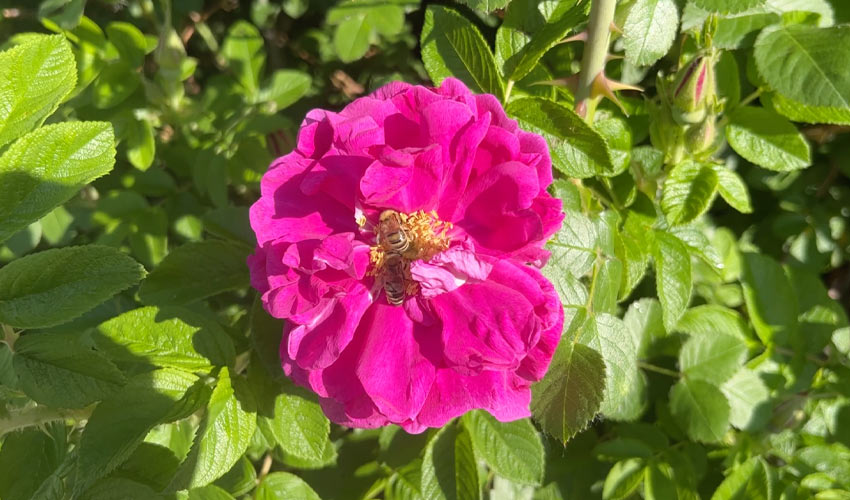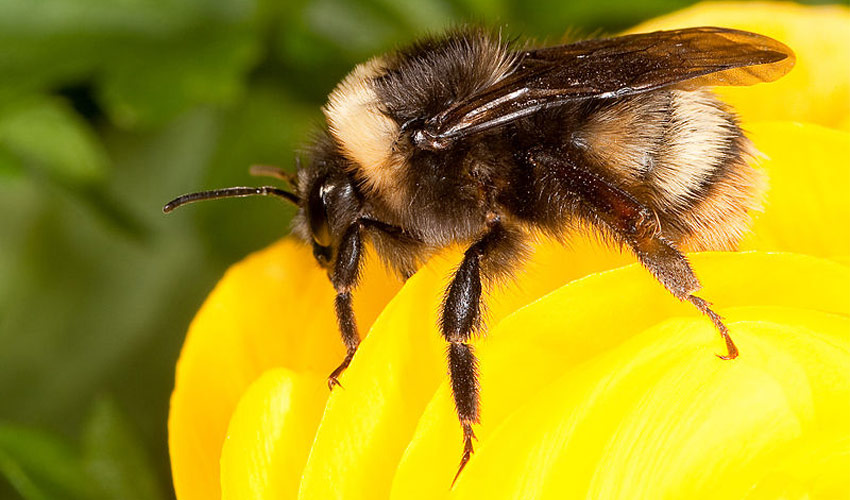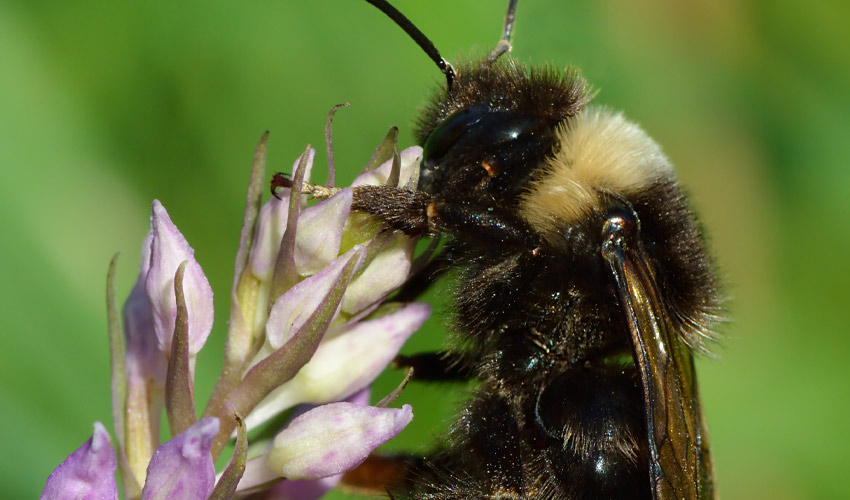A buzz on campus
Multiple bee initiatives underway at MRU
— Mount Royal University | Posted: September 7, 2023

Bees are an important part of the North American ecosystem.
Mount Royal University’s’ campus is buzzing with activity as two projects aim to help local bee populations and develop a better understanding of them.
Research is underway in the faculty of Science and Technology looking at a number of things related to the black and yellow critters, including the impact of pesticides on local native bee species; particularly the impact they have on bee survival and colony growth.
Meantime, Plan Bee is an ongoing effort to ensure the outdoor spaces around campus are pollinator friendly.
Examining bee colonies and the impact of pesticides
Bees are an important part of the North American ecosystem, however certain species have been declining in numbers over the past ten years. The cause or causes aren’t exactly known, according to Dr. Robin Owen PhD, professor in the department of Biology, but the downward trend is concerning.
“Bees are essential pollinators of the native wildflowers, and therefore are essential components of our ecosystem here and everywhere,” he said.
Most people, either through the news or social media, are aware of honeybee populations declining however Owen notes that the species is not native to North America and they are generally highly domesticated.
“It’s the native bees that we’re really concerned about,” he explains. “Having functioning ecosystems like forests, although we don’t notice every day,is essential for society to exist.”

The western bumblebee (Bombus occidentalis).
While a number of factors could and likely are at play when it comes to bee numbers going down. Owen and his research assistants Mikayla Wood, a recent Biology graduate, and Yanwei Yu, who is headed into his fourth year of Biology, are zeroing in on pesticides and what impact they might have.
“There is this heavy use of insecticides and pesticides both commercially from spraying canola as well as domestically, people spraying pesticides in their gardens.”
Owen says people should know just how dangerous some of these chemicals can be on an ecosystem and encourages gardeners to look for as many natural alternatives as they can.
His research project started back in the spring as he and his team ventured outside daily, collecting queen bees emerging from hibernation.
Those bees are actually the only ones who survive the winter, explains Owen, noting that it’s just a natural part of their lifecycle.
The queens are provided with pollen, sugar solution and a nesting cavity in the lab, which are all things they would find in nature. With those cues the bees laid eggs and began to raise their colonies.
As the colonies develop and become more established the researchers are able to perform multiple experiments and take different measurements.
“One thing we’re going to be doing is removing workers and measuring them to look at developmental stability or instability depending on whether they’ve been fed pesticides or not and many other things,” Owen explains.
The colonies have continued to grow throughout the summer and the research team is studying them and hoping to have some preliminary data in the fall. The winter months will see the team developing a more formal, detailed report on their findings.
Making campus pollinator friendly
Plan Bee is not a new initiative at MRU, in fact it’s been underway for several years now and it continues to grow (literally) every year.
The project is a collaboration involving pollination ecologist Alexandria Farmer, in the Department of Biology and the MRU Grounds team. Together they have designed areas of campus to be pollinator friendly; planting native species to help provide food sources for the bees.
Additionally, bee boxes have been set up offering a place to nest. And to add to the list of bee friendly practices, the Grounds team is cautious of where they are spraying pesticides and selective about what kinds they are using.
“It’s the idea that if you build it they will come. The more these plants are spreading we’re just seeing more and more diversity,” explains Farmer, stressing that this initiative is focused on science-based conservation efforts.
Wildflower hill, alongside the main Lincoln Park building across from Charlton Pond, features dozens of native plants and bee boxes. Each spring and summer sees new growth, offering habitat and food sources for the bees.

The cuckoo bumblebee (Bombus bohemicus). Photo courtesy Ivar Leidus.
Part of Plan Bee also means leaving sand and dirt piles alone. They might be eyesores to some, but for bees that burrow into the ground, they are a prime nesting space. If you look close enough in those areas you might see small holes where the bees have gone in and out.
“When you have huge diversity of pollinators, you have more diversity of plants and in places where we’ve seen declines in native pollinator diversity we’re also seeing declines in the diversity of the plants there,” says Farmer.
As much as the bees benefit from this initiative, it also helps students and the broader community.
“It provides really good educational opportunities. We can have students monitoring and getting involved in learning about the native plants and their ties with the native pollinators and learning about this incredible diversity that we have here in Alberta and right here in Calgary.”
While there’s no documented proof it’s because of Plan Bee it appears the initiative is already having an impact as Farmer says she’s seeing different species of bees.
“We have western bumblebees (Bombus occidentalis) here in Calgary and more recently the cuckoo bumblebee (Bombus bohemicus) that parasitizes it was also found. It was one we thought was extirpated for many years so it was exciting to see,” she says, explaining that the cuckoo bumblebee wouldn’t be here if there wasn’t a large population of the western bees.
Like Owen, Farmer also aims to correct misinformation about bee populations and educate about the difference between honeybees and bumblebees.
“They’re lovely and we need them,” Farmer says of honeybees, stressing that they are not part of nature but rather used in agriculture.
So what’s next for Plan Bee? Hopefully much of the same with new wild plants and flowers growing every year, attracting and offering habitats to all types of local pollinators.
Read more about the Faculty of Science and Technology at MRU.

